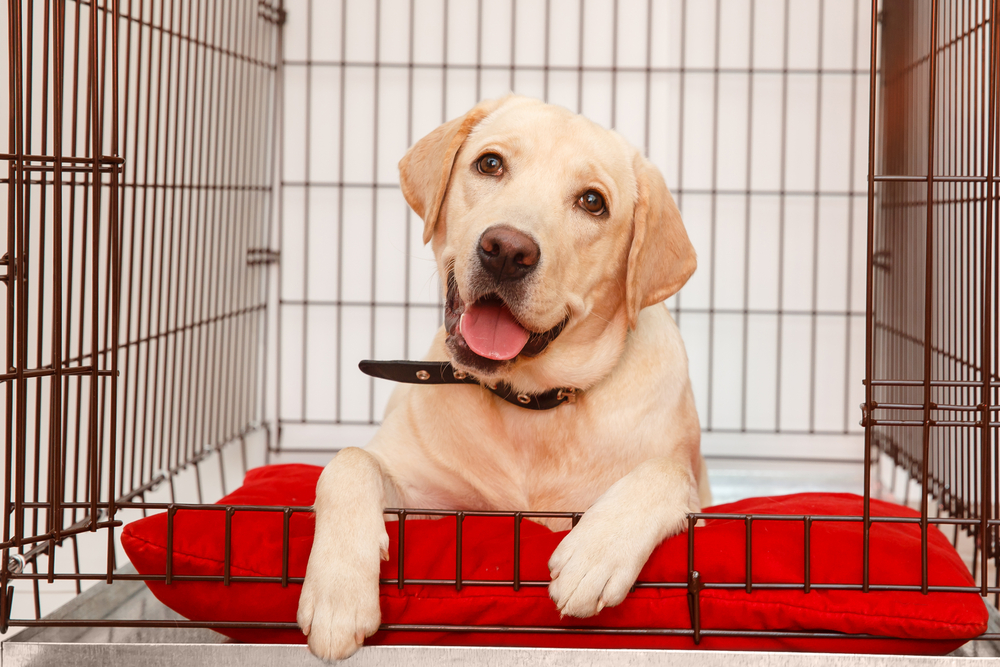Tuesdays with Tony
This one’s for the dogs. The unsophisticated, stinky, dogs. While no cat can be tamed, of course, dogs often need to be contained to prevent messes or not-so-smart choices. I know, it’s embarrassing, right? Dogs. But we should talk it out anyway, just so that we’re all on the same page with best practices.
What is Crate Training?
Crate training can be an effective way to housetrain your dog and teach them to be comfortable in their crate. Positive reinforcement is a great way to train dogs and puppies as it involves rewarding them for good behavior and basically ignoring the unwanted behaviors. There are a variety of different types of crates, so I’m sure you can find one that will work in your home. Here are some of the categories:
- Wire crates: Wire crates are one of the most popular types of crates. They are made of metal wire and usually have a removable plastic or metal pan at the bottom. They come in different sizes and often have a removable divider to make it easier to adjust the size of the crate as your puppy grows. They have good ventilation and are probably the simplest and most accessible to start with, and they are also easy to clean.
- Plastic crates: Plastic crates are another popular choice. They are made of hard plastic and usually have a removable plastic or metal pan at the bottom. They are lightweight, durable, and easy to clean. They are suitable for travel, as they are easy to fold and store. These aren’t the best idea if your dog is an aggressive chewer, as they can potentially chew and eat the plastic.
- Soft-sided crates: Soft-sided crates are made of fabric and mesh and are lightweight and portable. They often have a steel or aluminum frame for support. They are suitable for small dogs and for travel as they are easy to fold and store. They are not as durable as the wire or plastic crates. These should not be used for crate training but can be used once the dog is acclimatized to the concept.
- Wooden crates: Wooden crates are made of wood and are suitable for indoor use. They are not as durable as the wire or plastic crates and are not easy to clean. They are usually heavy and not suitable for travel. These are often the most aesthetically pleasing, and also the most expensive.
- Outdoor crates: Outdoor crates are made of heavy-duty materials such as metal wire or plastic, and they are designed to be used outside. If they are weather-resistant and have good ventilation, they can be useful for dogs that spend a lot of time outside. It is vital that they always have free access to water if they are outside and that they are not left outside in extreme conditions.

Making the Right Choice
It’s important to consider the size and behavior of your dog when choosing a crate. You should select a crate that is just large enough for your dog to stand up, turn around and lay down comfortably, initially. This specific sizing makes the initial crate training much easier. Once your dog is comfortable in the crate, you can try getting them a larger one, so they have more space, especially if you’re leaving them for the work day.
How Do You Do It?
So, how’s a human supposed to convince your new puppy or adult dog to go into a cage and stay there? Start by introducing your dog to the crate gradually. Place treats and toys inside the crate and let them explore it on their own. The goal is to make the crate a happy place to be. Once they are comfortable inside, you can start closing the door as you sit next to it. Ideally, they shouldn’t even notice the first few times because they’re so enthralled with whatever interesting thing you’ve put inside. This should happen the first day or two you bring your dog home.
This isn’t a new puppy blog, but I will say new puppies are going to cry at night pretty much no matter what (again, embarrassing). Some people choose to put them in their new crate next to their bed, others choose to put them in a pen, bathroom, or other safe space that is not the crate for their first few nights. Wherever you put them should be contained and fully puppy-proofed. That will be a future blog topic in itself, I’m sure. I hear Dr. Speziok talk about it to her clients every day, so it must be important. But enough on that for now. What was I saying? Ah, yes, crate training.

Gradually increase the amount of time you leave your dog in the crate, and always, always reward them with a treat when they go in. Avoid making a big fuss when you put your dog in the crate or when you let them out. This can create anxiety for your dog and make the process more difficult.
This is an important point that you humans sometimes have a hard time grasping: Crates are not to be used for punishment. Really, punishment is never a good training tool. You can use the crate when your dog needs to be removed from a situation AFTER they’ve gotten used to the crate and associate positive things with it, but it should always be a positive, happy experience to go into the crate. Some of the big brain humans that study animal behavior feel that many dogs think of their crate as a sort of “den.” They consider it their home within the home, and some will be seen to bring toys, bones, or food inside.
Why Crate Train?
A properly sized, properly conditioned crate provides dogs with a safe, private place that is all their own. It allows you to focus on that new Top Gun movie or on sniping in Fortnite (if you don’t know what that means, it’s similar to playing Bingo). It creates independence for both the dog and you and gives them a place to settle. Probably most importantly, for your carpets, at least, it massively improves housetraining success.
While I, as a self-respecting litter box user, have never had to wear a leash, Dr. Speziok always recommends new puppies be kept on a leash or in their crate for the first few weeks they are with you so you can make sure they always make it outside to eliminate. Rewarding good behavior is significantly better than trying to “punish” bad behavior after the fact, mostly because it doesn’t work. Yelling or rubbing a dog’s nose in their mess only makes them fear you, and makes them more likely to hide from you to eliminate in the home. If you become a scary person, they will not be willing to be vulnerable around you, even outside on the leash. This is one of the biggest mistakes that new dog owners make.
What if I Adopt An Adult Dog That’s Already Housetrained?
Every animal in your home should be comfortable going into a crate, cage, or pen of some sort in case of emergency. Yes, this includes cats, though we only acquiesce to that indignity in dire situations. And it’s exactly those dire situations that I’m talking about when I say emergency. For those of us in the southeast US, we know that hurricanes are a major worry during certain parts of the year. At any point, you humans could decide you need to leave your home, city, or even state, and you need to be able to take your animals with you, or at the very least get them to a safe weather-proof shelter. This will, unfortunately, necessitate them going into a crate.
So, even if your dog doesn’t need to be crated while you’re away at work, or at night, you should still go through the exercise of crate training them. Family emergencies, vacations, vet visits, emergency room visits, a tornado removing your roof; the reasons your pet might need to go in a crate on short notice are endless.
Try to take crate training slow and be patient with yourself, other members of your household, and your dog. Be consistent and positive and eventually your dog will be comfortable in their crate. Every dog is different, and some are more difficult (read: obstinate [pronounced: cat-like]) to train than others. Don’t be afraid to find a dog trainer in your area to help you out. Dr. Speziok also recommends two channels on the YouTube: Zak George Dog Training and Kikopup. Just click the highlighted link to visit them.
Oh, also… don’t tell the dogs I told you about this.
Until next week,
~ Tony
P.S. Speaking of YouTube Channels, make sure you subscribe to mine! Just click on that highlighted bit. It’s filled with great videos that will teach you way more about horses (and goats, and other things) than I’m willing to spend the time writing about. If you aren’t watching them, you’re missing out!
Tuesdays with Tony is the official blog of Tony the Clinic Cat at Springhill Equine Veterinary Clinic in Newberry, Florida. If you liked this blog, please subscribe below, and share it with your friends on social media! For more information, please call us at (352) 472-1620, visit our website at SpringhillEquine.com, or follow us on Facebook!
[jetpack_subscription_form title="Subscribe to Whinny's Wisdoms"]

